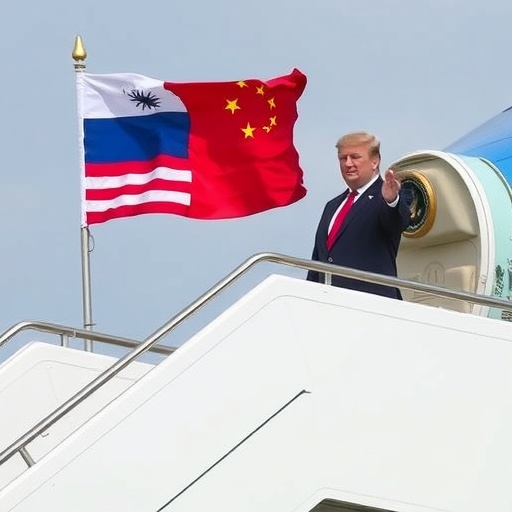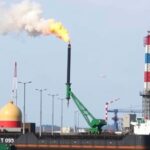Trump Seeks China’s Aid in Russia Peace Deal During High-Stakes Asia Trip to Japan, South Korea, and Malaysia
In a surprising diplomatic pivot, President Donald Trump has publicly called on China to assist the United States in brokering a peace deal with Russia, just as he embarks on a pivotal five-day Asia trip visiting Malaysia, Japan, and South Korea. The announcement, made en route to the region, underscores the unpredictable nature of Trump‘s foreign policy and highlights the intricate web of global alliances amid escalating tensions in Eastern Europe and the Indo-Pacific.
- Trump’s Direct Appeal to Xi Jinping Signals Shift in U.S.-China Dynamics
- Navigating Key Stops: Malaysia’s Neutral Ground for Asia Trip Diplomacy
- Japan and South Korea: Fortifying Alliances Amid Russia Peace Deal Talks
- Unpacking the Russia Peace Deal: Why China Holds the Key
- Expert Insights: Potential Outcomes of Trump’s China-Russia Diplomacy Push
Trump’s overture to Beijing comes at a time when U.S.-Russia relations are at a historic low, exacerbated by ongoing conflicts and sanctions. During a press briefing aboard Air Force One, Trump stated, “China has a lot of influence, and I think President Xi Jinping and I can work something out. We need peace with Russia, and China’s help would be tremendous.” This bold move sets the stage for a high-level meeting with Xi Jinping later this week, potentially reshaping the geopolitical landscape.
The Asia trip, which kicks off in Kuala Lumpur, is not just about bilateral talks but also about reinforcing American presence in a region where China’s economic dominance is rapidly expanding. With trade deals, security pacts, and the looming shadow of the Russia-Ukraine crisis influencing every stop, Trump’s itinerary promises to be a whirlwind of negotiations and photo ops. Analysts are buzzing about whether this outreach to China could thaw frosty relations or merely serve as a tactical distraction from domestic challenges back home.
Trump’s Direct Appeal to Xi Jinping Signals Shift in U.S.-China Dynamics
At the heart of Trump’s Asia trip is his anticipated face-to-face with Chinese President Xi Jinping, a meeting that could mark a turning point in the often-contentious U.S.-China relationship. Trump, known for his deal-making bravado, has framed the request for China’s involvement in a Russia peace deal as a pragmatic step toward global stability. “Xi is a strong leader, and together we can pressure Russia to come to the table,” Trump remarked, echoing sentiments from his 2016 campaign promises of unconventional diplomacy.
Historically, China has maintained a delicate balancing act in its ties with both the U.S. and Russia. As a key buyer of Russian energy exports—importing over 20% of its oil from Moscow in recent years—Beijing has economic incentives to support stability in Eurasia. Yet, China’s Belt and Road Initiative has deepened ties with Russia, complicating any direct intervention. Experts note that Trump’s appeal taps into this interdependence, potentially leveraging U.S. tariffs and technology restrictions as bargaining chips.
During the Asia trip, Trump is expected to raise the Russia peace deal in informal sideline discussions, building on previous summits like the 2019 Osaka G20 meeting where he and Xi forged a temporary truce on trade. White House officials, speaking anonymously, revealed that preparations include briefing papers on Russia’s military posture and China’s potential mediation role, drawing parallels to Beijing’s successful brokering of the 2023 Iran-Saudi Arabia détente.
The stakes are high: A successful collaboration could ease U.S. sanctions on Russia, benefiting global energy markets where prices have surged 15% year-over-year due to the conflict. However, critics warn that involving China risks legitimizing its territorial claims in the South China Sea, a flashpoint during Trump’s visits to Japan and South Korea.
Navigating Key Stops: Malaysia’s Neutral Ground for Asia Trip Diplomacy
Trump’s Asia trip begins in Malaysia, a nation strategically positioned as a neutral hub in Southeast Asia, offering a low-key start to what promises to be an intense itinerary. Kuala Lumpur’s role is crucial, as Malaysia chairs the Association of Southeast Asian Nations (ASEAN) and has historically mediated between superpowers. Trump is slated to meet Malaysian Prime Minister Anwar Ibrahim to discuss economic partnerships, but the undercurrent of the Russia peace deal looms large.
Malaysia’s economy, heavily reliant on palm oil exports and semiconductors, stands to gain from U.S. investments aimed at countering China’s regional influence. In 2023, bilateral trade reached $80 billion, with Trump pushing for more American tech firms to relocate supply chains from China. Yet, the visit isn’t without controversy; local activists protest U.S. involvement in regional arms sales, fearing escalation in the Taiwan Strait.
Behind closed doors, Trump plans to gauge Malaysia’s stance on the Russia peace deal, given its abstention in UN votes condemning Moscow. “We’re looking for allies who can talk to everyone,” a State Department spokesperson said. This stop also allows Trump to address the fentanyl crisis indirectly, as Malaysia serves as a transit point for precursors from China, tying domestic U.S. concerns to international diplomacy.
From Malaysia, the Asia trip moves to Japan, where Prime Minister Fumio Kishida awaits discussions on defense cooperation. Japan, hosting 54,000 U.S. troops, views Russia’s actions in Ukraine as a blueprint for potential aggression in the East China Sea. Trump is expected to announce $10 billion in joint military exercises, emphasizing the quadrilateral alliance with Australia, India, and the U.S. (Quad) as a bulwark against both Russian and Chinese expansionism.
Japan and South Korea: Fortifying Alliances Amid Russia Peace Deal Talks
In Tokyo, Trump’s Asia trip intensifies with talks centered on economic security and the Russia peace deal’s ripple effects. Japan, the world’s third-largest economy, has imposed stringent sanctions on Russia, freezing $100 billion in assets and halting energy imports. Prime Minister Kishida has voiced support for U.S.-led peace initiatives, but insists on including North Korea denuclearization in any broader framework—a nod to the region’s interconnected threats.
Trump’s visit coincides with the rollout of new U.S.-Japan semiconductor pacts, valued at $5 billion, aimed at reducing dependence on Chinese manufacturing. “This trip is about strength and deals,” Trump tweeted from the plane, highlighting his administration’s “America First” approach. Yet, the Russia angle introduces complexity; Japan’s concerns over Russian forces near the Kuril Islands could make it a vocal advocate for China’s involvement, provided it aligns with democratic values.
Moving to Seoul, the Asia trip culminates in meetings with South Korean President Yoon Suk-yeol, where the focus sharpens on trilateral U.S.-Japan-South Korea coordination. South Korea, a powerhouse in shipbuilding and batteries, exported $30 billion in goods to the U.S. last year and has ramped up arms sales to Ukraine, including artillery shells worth $500 million. Yoon has praised Trump’s direct style, stating in a recent interview, “The president’s willingness to engage China on Russia could stabilize our backyard.”
However, tensions persist: North Korea’s recent missile tests, numbering over 100 in 2023, heighten urgency. Trump may propose extending the Russia peace deal template to Pyongyang, using China’s leverage over its ally. Economic talks will cover the U.S.-Korea Free Trade Agreement, with potential revisions to boost American auto exports amid EV competition from Chinese firms like BYD.
The Asia trip’s Seoul leg also addresses human rights, with Trump expected to press Yoon on labor reforms in shipyards, tying into broader U.S. supply chain resilience efforts against Russian disruptions in Black Sea grain routes.
Unpacking the Russia Peace Deal: Why China Holds the Key
The Russia peace deal at the core of Trump’s Asia trip represents a multifaceted challenge, blending military, economic, and diplomatic threads. Since the 2022 invasion of Ukraine, over 500,000 troops have been engaged, with global repercussions including a 25% spike in wheat prices and refugee flows exceeding 6 million. Trump’s vision, as outlined in recent speeches, envisions a ceasefire that restores pre-2022 borders while easing sanctions on Russian agriculture.
China’s potential role is pivotal due to its veto power in the UN Security Council and its $200 billion annual trade with Russia. Beijing has refrained from condemning the invasion outright, instead calling for dialogue—a position that aligns with Trump’s pragmatic stance. In a 2023 white paper, China proposed a “peaceful resolution” framework, which U.S. diplomats now see as a starting point for collaboration.
Statistics underscore the urgency: Europe’s energy imports from Russia dropped 40%, driving up LNG prices that the U.S. has filled with exports tripling to 100 million tons in 2023. A deal facilitated by China could normalize these flows, benefiting American producers while curbing inflation. Yet, risks abound; Russia’s President Vladimir Putin has dismissed U.S. overtures, and any Chinese mediation might demand concessions on Taiwan or Xinjiang sanctions.
Domestic U.S. politics add layers: With midterm elections looming, Trump’s Asia trip and the Russia peace deal gambit aim to project strength abroad, countering narratives of isolationism. Polls from Pew Research show 60% of Americans favor diplomatic solutions over escalation, providing Trump with public backing.
International reactions vary: NATO allies like Germany express skepticism, fearing a weakened front, while India—another Quad member—welcomes China’s involvement, having abstained on UN resolutions to protect its Russian arms deals worth $10 billion annually.
Expert Insights: Potential Outcomes of Trump’s China-Russia Diplomacy Push
As Trump’s Asia trip unfolds, geopolitical experts are dissecting the implications of enlisting China in the Russia peace deal. Dr. Evelyn Farkas, former U.S. Deputy Assistant Secretary of Defense, warns, “This could be a masterstroke or a miscalculation—China gains leverage over both rivals.” Farkas points to historical precedents like the 1972 Nixon-Mao thaw, suggesting Trump’s move might similarly realign power blocs.
Economists at the Brookings Institution forecast that a successful deal could shave 2% off global GDP losses from the conflict, estimated at $2.8 trillion by the World Bank. For Asia, stability means boosted tourism and trade; Japan’s Nikkei index rose 5% on news of the trip, anticipating de-escalation dividends.
In South Korea, think tanks like the Asan Institute emphasize cybersecurity angles, noting Russia’s alleged hacks on Ukrainian grids as a model for potential Asian threats. Trump’s discussions may yield new intelligence-sharing pacts, fortifying the region against hybrid warfare.
Looking ahead, the Xi meeting could spawn working groups on mediation, with follow-ups at the G20 in Brazil. If fruitful, it might extend to climate talks, where Russia and China have stalled Paris Agreement progress. Failure, however, risks heightened U.S.-China tariffs, impacting $600 billion in annual trade.
Ultimately, Trump’s Asia trip and pursuit of a Russia peace deal via China signal a high-wire act in diplomacy—one that could redefine alliances for the 2020s, fostering unexpected partnerships or deepening divides. As the president lands in Malaysia, the world watches to see if this unorthodox strategy yields peace or merely more posturing.










